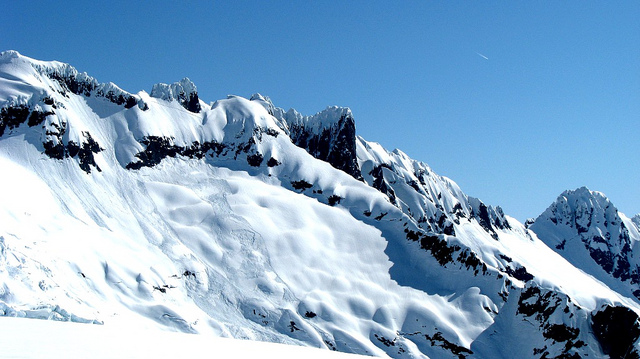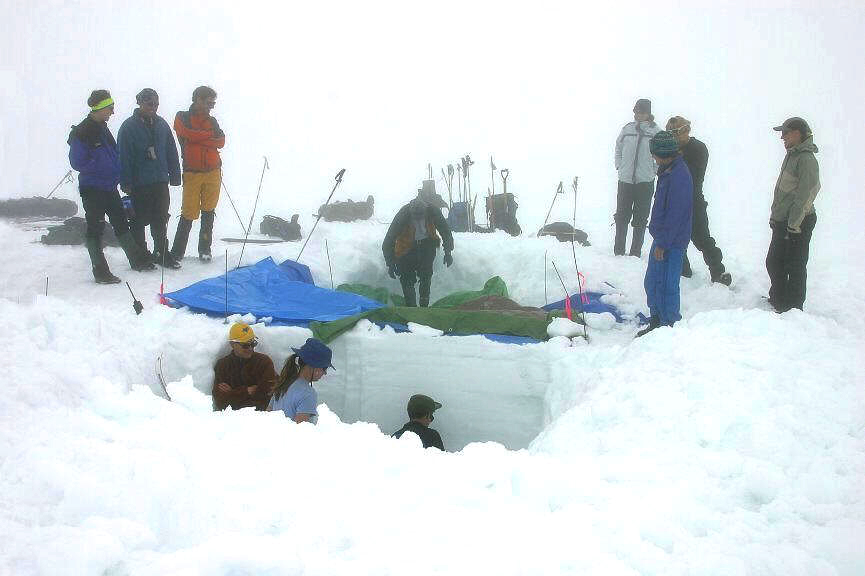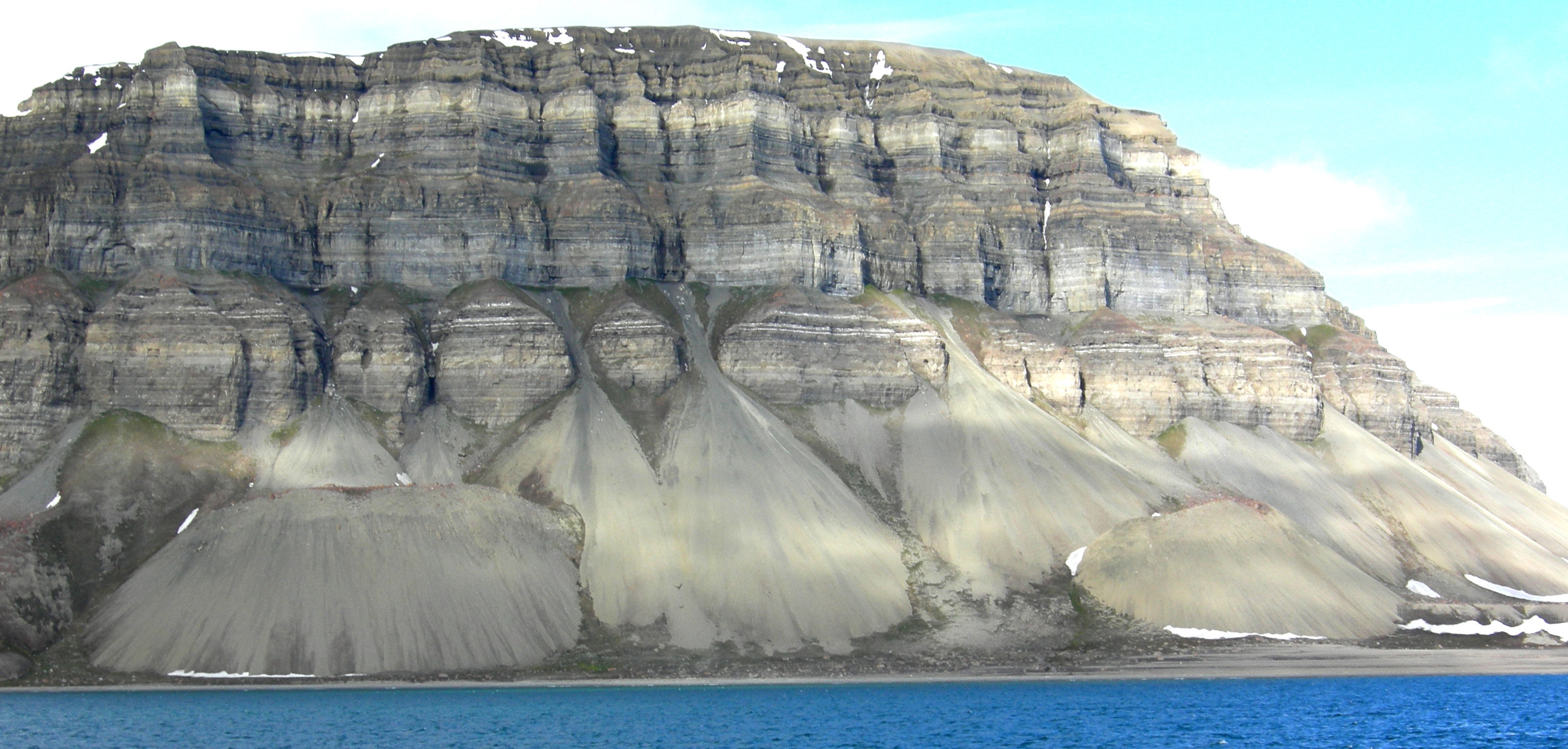|
Avalanche
An avalanche is a rapid flow of snow down a Grade (slope), slope, such as a hill or mountain. Avalanches can be triggered spontaneously, by factors such as increased precipitation or snowpack weakening, or by external means such as humans, other animals, and earthquakes. Primarily composed of flowing snow and air, large avalanches have the capability to capture and move ice, rocks, and trees. Avalanches occur in two general forms, or combinations thereof: slab avalanches made of tightly packed snow, triggered by a collapse of an underlying weak snow layer, and loose snow avalanches made of looser snow. After being set off, avalanches usually accelerate rapidly and grow in mass and volume as they capture more snow. If an avalanche moves fast enough, some of the snow may mix with the air, forming a powder snow avalanche. Though they appear to share similarities, avalanches are distinct from slush flows, Mudflow, mudslides, Landslide#Debris landslide, rock slides, and serac collap ... [...More Info...] [...Related Items...] OR: [Wikipedia] [Google] [Baidu] |
Avalanche Control
Avalanche control or avalanche defense activities reduce the hazard avalanches pose to human life, activity, and property."Mitigation and Land Use - Avalanches" , Colorado Geological Survey Avalanche control begins with a risk assessment conducted by surveying for potential avalanche terrain by identifying geographic features such as vegetation patterns, drainages, and seasonal snow distribution that are indicative of avalanches. From the identified avalanche risks, the hazard is assessed by identifying threatened human geographic features such as roads, ski-hills, and buildings. Avalanche control programs address the avalanche hazard by formulating prevention and mitigation plans, which are then executed during the winter season. The prevention and mitigation plans combine extensive snow pack observation ... [...More Info...] [...Related Items...] OR: [Wikipedia] [Google] [Baidu] |
Snow
Snow consists of individual ice crystals that grow while suspended in the atmosphere—usually within clouds—and then fall, accumulating on the ground where they undergo further changes. It consists of frozen crystalline water throughout its life cycle, starting when, under suitable conditions, the ice crystals form in the atmosphere, increase to millimeter size, precipitate and accumulate on surfaces, then metamorphose in place, and ultimately melt, slide, or Sublimation (phase transition), sublimate away. Snowstorms organize and develop by feeding on sources of atmospheric moisture and cold air. Snowflakes Nucleation, nucleate around particles in the atmosphere by attracting supercooling, supercooled water droplets, which Freezing, freeze in hexagonal-shaped crystals. Snowflakes take on a variety of shapes, basic among these are platelets, needles, columns, and Hard rime, rime. As snow accumulates into a snowpack, it may blow into drifts. Over time, accumulated snow m ... [...More Info...] [...Related Items...] OR: [Wikipedia] [Google] [Baidu] |
Snowpack
Snowpack is an accumulation of snow that compresses with time and melts seasonally, often at high elevation or high latitude. Snowpacks are an important water resource that feed streams and rivers as they melt, sometimes leading to flooding. Snowpacks provide water to down-slope communities for drinking and agriculture. High-latitude or high-elevation snowpacks contribute mass to glaciers in their accumulation zones, where annual snow deposition exceeds annual melting. Assessing the formation and stability of snowpacks is important in the study and prediction of avalanches. Scientists study the physical properties of snow under different conditions and their evolution, and more specifically snow metamorphism, snow hydrology (that is, the contribution of snow melt to catchment hydrology), the evolution of snow cover with climate change and its effect on the ice–albedo feedback and hydrology, both on the ground and by using remote sensing. Snow is also studied in a more global c ... [...More Info...] [...Related Items...] OR: [Wikipedia] [Google] [Baidu] |
Natural Hazard
A natural disaster is the very harmful impact on a society or community brought by natural phenomenon or hazard. Some examples of natural hazards include avalanches, droughts, earthquakes, floods, heat waves, landslides - including submarine landslides, tropical cyclones, volcanic activity and wildfires. Additional natural hazards include blizzards, dust storms, firestorms, hails, ice storms, sinkholes, thunderstorms, tornadoes and tsunamis. A natural disaster can cause loss of life or damage property. It typically causes economic damage. How bad the damage is depends on how well people are prepared for disasters and how strong the buildings, roads, and other structures are. Scholars have argued the term "natural disaster" is unsuitable and should be abandoned. Instead, the simpler term ''disaster'' could be used. At the same time, the type of hazard would be specified. A disaster happens when a natural or human-made hazard impacts a vulnerable community. It r ... [...More Info...] [...Related Items...] OR: [Wikipedia] [Google] [Baidu] |
Landslide
Landslides, also known as landslips, rockslips or rockslides, are several forms of mass wasting that may include a wide range of ground movements, such as rockfalls, mudflows, shallow or deep-seated slope failures and debris flows. Landslides occur in a variety of environments, characterized by either steep or gentle slope gradients, from mountain ranges to coastal cliffs or even underwater, in which case they are called submarine landslides. Gravity is the primary driving force for a landslide to occur, but there are other factors affecting slope stability that produce specific conditions that make a slope prone to failure. In many cases, the landslide is triggered by a specific event (such as heavy rainfall, an earthquake, a slope cut to build a road, and many others), although this is not always identifiable. Landslides are frequently made worse by human development (such as urban sprawl) and resource exploitation (such as mining and deforestation). Land degradation freque ... [...More Info...] [...Related Items...] OR: [Wikipedia] [Google] [Baidu] |
Snowboarder Triggered Soft Slab Near Mount Baker
Snowboarding is a recreational and competitive activity that involves descending a snow-covered surface while standing on a snowboard that is almost always attached to a rider's feet. It features in the Winter Olympic Games and Winter Paralympic Games. Snowboarding was developed in the United States, inspired by skateboarding, sledding, surfing, and skiing. It became popular around the world and was introduced as a Winter Olympic Sport at Nagano in 1998 and featured in the Winter Paralympics at Sochi in 2014. , its popularity (as measured by equipment sales) in the United States peaked in 2007 and has been in a decline since. History The first snowboards were developed in 1965 when Sherm Poppen, an engineer in Muskegon, Michigan, invented a toy for his daughters by fastening two skis together and attaching a rope to one end so he would have some control as they stood on the board and glided downhill. Dubbed the "snurfer" (combining snow and surfer) by his wife Nancy, the ... [...More Info...] [...Related Items...] OR: [Wikipedia] [Google] [Baidu] |
Slush Flow
A slushflow is rapid mass movement of water and snow, and is categorized as a type of debris flow. Slushflows are caused when water reaches a critical concentration in the snowpack due to more water inflow than outflow. The high water concentration weakens the cohesion of the snow crystals and increases the weight of the snowpack. A slushflow is released when the component of the force of gravity parallel to the slope generates a hydraulic pressure gradient exceeding the tensile strength and basal friction of the snowpack. While frequently compared to an avalanche, they have some key differences. Slushflows are lower in frequency than avalanches, have higher water content, are more laminar in flow, and have lower velocity. They most commonly occur at higher latitudes in the winter during high precipitation and in the spring during high snowmelt. Because of their high water content, they can flow down gentle slopes of only a few degrees at low altitudes. They are a significant ... [...More Info...] [...Related Items...] OR: [Wikipedia] [Google] [Baidu] |
Mass Wasting
Mass wasting, also known as mass movement, is a general term for the movement of rock (geology), rock or soil down slopes under the force of gravity. It differs from other processes of erosion in that the debris transported by mass wasting is not Entrainment (physical geography), entrained in a moving medium, such as water, wind, or ice. Types of mass wasting include Downhill creep, creep, solifluction, rockfalls, debris flows, and landslides, each with its own characteristic features, and taking place over timescales from seconds to hundreds of years. Mass wasting occurs on both terrestrial and submarine slopes, and has been observed on Earth, Mars, Venus, Jupiter's moon Io (moon), Io, and on many other bodies in the Solar System. Subsidence is sometimes regarded as a form of mass wasting. A distinction is then made between mass wasting by subsidence, which involves little horizontal movement, and mass wasting by slope movement. Rapid mass wasting events, such as landslides, ca ... [...More Info...] [...Related Items...] OR: [Wikipedia] [Google] [Baidu] |
Angle Of Repose
The angle of repose, or critical angle of repose, of a granular material is the steepest angle of descent or Strike and dip, dip relative to the horizontal plane on which the material can be piled without slumping. At this angle, the material on the slope face is on the verge of sliding. The angle of repose can range from 0° to 90°. The morphology of the material affects the angle of repose; smooth, rounded Sand, sand grains cannot be piled as steeply as can rough, Shear strength (soil), interlocking sands. The angle of repose can also be affected by additions of solvents. If a small amount of water is able to bridge the gaps between particles, electrostatic attraction of the water to mineral surfaces increases the angle of repose, and related quantities such as the bearing capacity, soil strength. When bulk granular materials are poured onto a horizontal surface, a cone (geometry), conical pile forms. The internal angle between the surface of the pile and the horizontal sur ... [...More Info...] [...Related Items...] OR: [Wikipedia] [Google] [Baidu] |
Cornice (climbing)
A snow cornice or simply cornice (from the Italian cornice meaning "ledge") is an overhanging edge of snow on a ridge or the crest of a mountain and along the sides of gullies. Formation A snow cornice forms by wind blowing snow over sharp terrain breaks (e.g. the crest of the mountain) where it attaches and builds out horizontally. This build-up is most common on the steeper and leeward sides of mountains. Cornices are extremely dangerous and travelling above or below them should be avoided. When a cornice ''collapses'', it breaks in from the cornice to the top of the peak; even being on the snow on top of rock exposes the alpinist to hazard in this situation. The best practice in mountaineering is to stay far enough back from the edge so as not to be able to see the drop, as an approximate metric of exposure. Interview und Bilder zum Unglück In avalanche safety, cornices are a high avalanche danger as they often break and trigger larger avalanches that permeate several sno ... [...More Info...] [...Related Items...] OR: [Wikipedia] [Google] [Baidu] |
Powder Snow Avalanche
thumbnail, Example of powder snow avalanche A powder snow avalanche is a type of avalanche where snow grains are largely or completely suspended and moved by air in a state of fluid turbulence. They are particle-laden gravity currents and closely related to turbidity currents, pyroclastic flows from volcanoes and dust storms in the desert. The turbulence is typically generated by the forward motion of the current along the lower boundary of the domain, the motion being in turn driven by the action of gravity on the density difference between the particle-fluid mixture and the ambient fluid. The ambient fluid is generally of similar composition to (and miscible with) the interstitial fluid, and is water for turbidity currents and air for avalanches. These flows are non-conservative in that they may exchange particles at the lower boundary by deposition or suspension, and may exchange fluid with the ambient by entrainment or detrainment. Such flows dissipate when the turbule ... [...More Info...] [...Related Items...] OR: [Wikipedia] [Google] [Baidu] |







